|
– Part 2: Tech Specs, Special Features and Summary –
All five features were restored in 4K from the original 35mm negatives by Final Frame Post in London from materials supplied by StudioCanal, whose logo appears at the start of each film. All are in great shape, with nicely balanced and sometimes punchy contrast, solid black levels and decent shadow detail, and often crisp image detail. The colours are nicely reproduced, with brighter hues and prime colours vividly captured. Almost all instances of dust and dirt have been removed and a fine film grain is visible on each transfer. There are a few specifics worth noting for each film.
The Face of Fu Manchu is the only one of the five films shot in the 2.35:1 aspect ratio, and when you elect to play it you are offered two choices. During the course of scanning the original negative, extensive damage was discovered on the left-hand side of reel three that had been disguised on the theatrical release print by zooming into the picture. Here you are offered the option of watching the film as it was originally projected, with a slightly cropped picture during reel three, or with the entire picture area visible, including the damaged portion. I chose the latter and didn’t think it was that bad, but could see why the decision was made to disguise it on its initial theatrical run. The soundtrack is DTS-HD Master Audio 1.0 mono, and while always clear, it does show its age in restrictions to the dynamic range that render some of the dialogue a tad shrill, particularly if you have the volume up. There’s also a very faint background hum, but you’ll have to be playing it loud to really hear it.
The Brides of Fu Manchu is framed 1.85:1 and you have the option to watch either the UK version or the US version, which has a prologue that recycles the finale of the previous film for those who missed it and don’t know who Fu Manchu is or what he’s been up to. Again the soundtrack here is DTS-HD Master Audio 1.0 mono, and there’s no trace of hiss or damage, and some of the music (the ballet performance at which a kidnapping attempt takes place) and sound effects have surprisingly strong clarity and breadth.
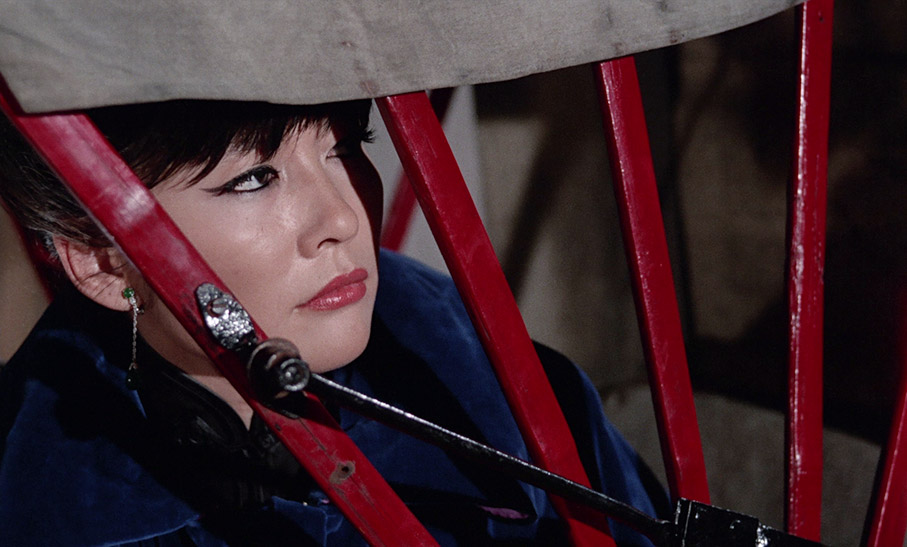
The Vengeance of Fu Manchu is framed 1.66:1 (getting narrower!) and has lively colour reproduction (the Blue of Nayland Smith’s car and some of the costumes really pop) and some of the crispest picture detail of the series. This is the only soundtrack in the set that is Linear PCM 1.0 mono, and this is clear with no obvious evidence of wear and the expected range restrictions on dialogue, music and effects.
The Blood of Fu Manchu is also framed 1.66:1 and has the option to play the film either as The Blood of Fu Manchu or the American release title of Kiss Me to Death. Apart from the title sequence, there appears to be no difference between the two. There is a very slightly warmer hue on the some of the interiors here than on its predecessors, but brighter colours still shine and for the most part this is on a par with its companions. The soundtrack is once again DTS-HD Master Audio 1.0 mono, and the audio quality feels a slight step down here, something most noticeable on the dialogue, where the slightly narrower range adds to the film’s low-budget vibe.
Finally we have The Castle of Fu Manchu, which is also framed 1.66:1 and does have some mild flickering on the opening shot and later on a clear blue sky, but is otherwise in fine shape. Franco’s use of coloured lighting is vividly captured here. Another DTS-HD Master Audio 1.0 mono soundtrack that does the job well enough but whose range restrictions again add to the low budget feel, though the dialogue is always clearly captured.
All five films have optional English subtitles for the deaf and hearing impaired.
THE FACE OF FU MANCHU
Audio Commentary with Stephen Jones and Kim Newman
The ever-enthusiastic and knowledgeable team of writer and horror editor Stephen Jones and critic and novelist Kim Newman deliver a typically lively commentary on a film Jones regards as close to perfect and both men clearly hold in high regard. With you on that one, chaps. They talk about the film’s use of locations, the series’ continent hopping, novel author Sax Rohmer, actor Tsai Chin, writer-producer Harry Alan Towers, why this film was certificated for family viewing while Hammer horrors landed X certificates, the thorny topic of casting Caucasians in Asian roles, and plenty more. Immensely enjoyable.
BEHP Interview with Don Sharp – Part One (95:41)
The first part of a British Entertainment History Project interview with director Don Sharp, who lives up to his surname with his precise and engaging memories of his early years in Australia and how he was drawn into theatre through acting and writing. This leads on to talk about his relocation to London, his early work in documentary filmmaking, getting together with friends to make his first low-budget independent feature, Ha’penny Breeze, and a whole lot more. The sheer detail that Sharp goes into on each subject is fascinating in itself, and the way he almost brushes off two years of tuberculosis treatment that left him minus six ribs and a lung tells you so much about his strength of character and determination to get back into filmmaking afterwards. His subsequent work is covered in similar detail on a film-by-film basis and is never less than fascinating and sometimes illuminating. This first part ends, appropriately, shortly after discussion about The Face of Fu Manchu has concluded and includes an interesting story about having to pay the IRA to use the opening castle courtyard location. As ever, this runs under the film as a second commentary track.
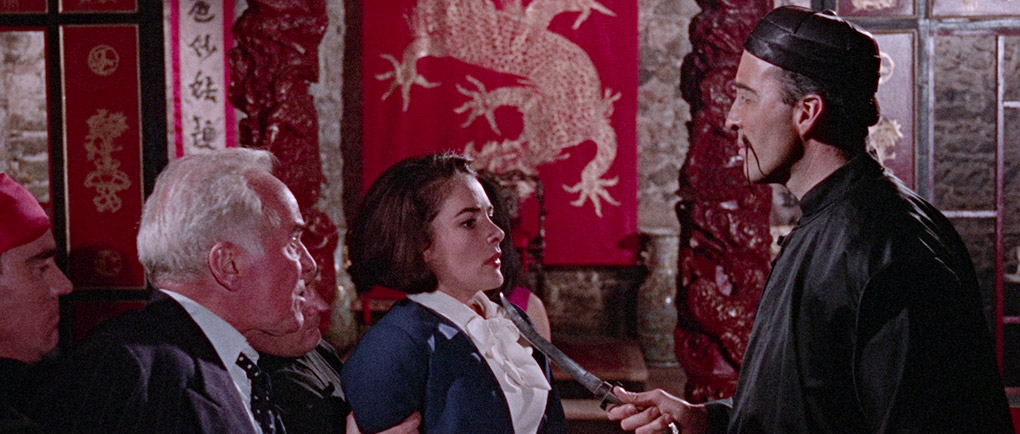
BEHP Interview with Ernest Steward – Part One (95:55)
This second British Entertainment History Project recording, which also plays as a commentary track and is also part one of a two-part piece that is concluded on the next disc, is with the first two films’ cinematographer, Ernest Steward, and while he also looks back on his career, there’s a lot more focus here (no pun intended) on the technical aspects of his particular art. He recalls working with Hitchcock back when he was a contract director and realising even then that this guy had something, talks about the formation of Association of Cine-Technicians union (later to become known as the ACTT), and reminds us of darker days with a story about when fellow cinematographer Jack Cox was arrested in a police raid simply because he was gay. I did like his story about getting one over on a colleague who liked to punch him in the arm as a greeting.
Archival Interview with Christopher Lee (3:54)
An interview with Christopher Lee, conducted during the filming of The Face of Fu Manchu by Des Koegh and broadcast in February 1965. In it, Lee talks about accidentally becoming a horror star, showing the human side of a villainous character and playing the role seriously, and the appeal of horror movies.
Introduction by Vic Pratt (6:51)
A nicely compact introduction from BFI video producer Vic Pratt, who although appears to be reading from just off-camera prompts (I may be wrong, but his eye movements suggest otherwise), provides a neat overview of the film and its pleasures. He praises Don Sharp’s direction, Ernest Steward’s cinematography, Lee’s portrayal of Fu Manchu and Nigel Green’s performance as Nayland Smith, and points out a few things that are incongruous to the supposed 1925 period setting. He also notes the Bond supervillain influence on Fu Manchu’s lair and equipment.
Christopher Frayling: Underneath the Skin (48:35)
I’ll be honest, I could listen to writer and educationalist Christopher Frayling talk for hours on end about just about anything. His wide-ranging and in-depth knowledge of so many areas of film and literature – often informed by interviews he has conducted with writers, actors and filmmakers – coupled with his calm but infectious enthusiasm for his subject, ensures that any contribution he makes to a disc release is worth giving your undivided attention to. Such is the case here, as Frayling examines the five films in this series, the books from which they drew inspiration and their author, Sax Rohmer, in enthralling and sometimes revealing detail. He looks at the origin of the Fu Manchu character, outlines some historical details that fuelled the writing of the books, and discusses the various film adaptations, citing the 1923 short film series The Mystery of Dr. Fu Manchu as the most faithful to Rohmer and the 1932 The Mask of Fu Manchu, starring Boris Karloff, as possibly the most racist film ever made in Hollywood. Like Jones and Newman above, he holds The Face of Fu Manchu in high regard and even calls it director Don Sharp’s masterpiece, and specifies why he believes none of its sequels were of the same calibre.
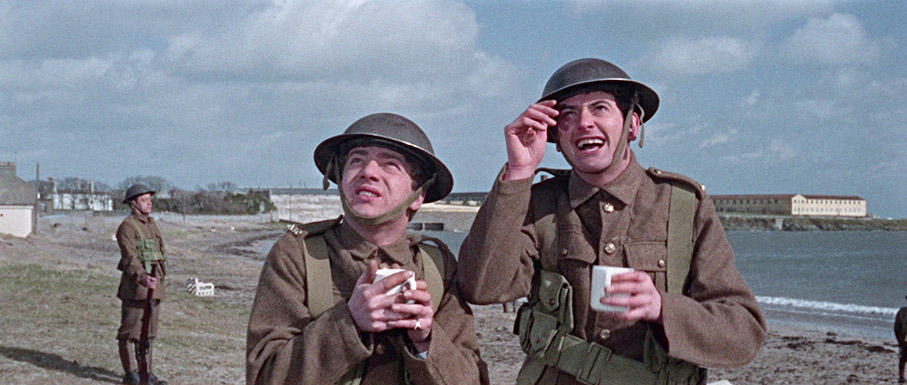
Alternative Title Sequences
Included here are the US Titles (1:38), whose principal difference to the one of the UK print is that Harry Alan Towers is credited as Peter Welbeck in his role as producer, and Oliver Unger gets an executive producer credit here. We also have the French opening titles and closing credits as Le Masque de Fu Manchu (2:38), and El regress de Fu Manchú (1:38), where the Spanish title replaces the English language one while all the other credits remain in English.
Super 8 Versions (15:38)
A severely cut-down Super-8 version that has been cropped to the 4:3 aspect ratio and stripped of both its colour and most of its story. Here Maria is kidnapped and taken to Fu Manchu’s lair, where an operative is executed for trying to help Maria’s father, then Nayland Smith makes his first appearance to effect a rescue. The remainder of the running time is spent on the Tibetan climax. I’m sure Don Sharp would have recoiled in horror. This version was originally released silent in two parts with large subtitles to clarify the dialogue, but vinyl soundtracks of both episodes were also made available and could be used to provide a synchronous soundtrack is started at the same time as the films (good luck with that). These have been added to the soundtrack here to create, in the words of the introduction to this extra, “the authentic 1965 home cinema experience.” Visually and aurally it’s in a bit of a state, but this is still rare enough to be a welcome inclusion for completists.
Trailers
Included here are three international trailers for the film. The UK Trailer (2:34) is smartly assembled and does a fair job of selling at least some the film’s qualities. The German Trailer (3:03) has a more languid pace and intrigues for the spectacle of its lead characters re-dubbed with mismatched German voices. A textless version of the French Trailer (2:33) takes its cue from the British one, with French narration and dubbing of the dialogue, though giveaway close-ups of faces are largely avoided.
Image Gallery
A generous 97 screens of promotional photos, lobby cards, posters, press book scans, a couple of behind-the-scenes stills and, of course, the much-discussed-in-the-extras ‘Fu Manchu for Mayor’ poster that was plastered all over New York to push the film’s release there.
THE BRIDES OF FU MANCHU
Audio Commentary with Kevin Lyons and Jonathan Rigby
The first of two commentaries in this set by author and horror expert Jonathan Rigby and Encyclopaedia of Fantastic Films and Television website editor Kevin Lyons is an engaging mixture of personal opinion and sometimes revealing background detail on the film, with a competition run by Harry Alan Towers to recruit some of the brides of the title and the news that the producer was known at one point as ‘Conning’ Towers amongst my favourites. Indeed, there is plenty on Towers and his career here, plus information on some of the actors and a few observations about period anachronisms and some surprise at the period accuracy of one small element. Lyons and Rigby are not alone in seeing Fu Manchu as a Dracula figure, though we part company a little over their professed preference for Douglas Wilmer over Nigel Green as Nayland Smith. I’m with Vic Pratt on this one (see below).
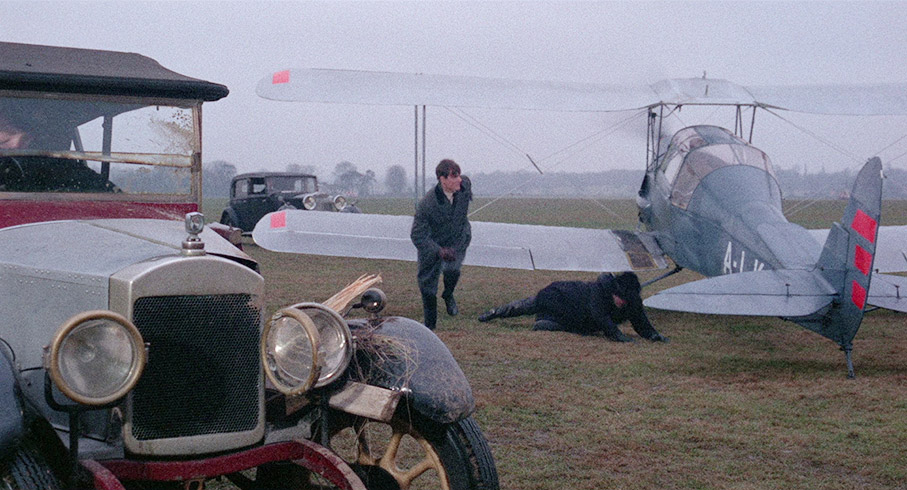
The BEHP Interview with Don Sharp – Part Two (94:55)
The second half of the British Entertainment History Project interview with Don Sharp is every bit as informative and enjoyable as the first. Sharp is such an engaging raconteur and has very clear memories of seemingly every film he worked on and plenty of stories of working with actors and with Harry Alan Towers. What really hits home in this second segment, however, is how difficult it was (and probably still is) to get a film funded, as Sharp relates story after story of projects that were developed, cast and almost ready to go that then collapsed because the money either fell through or couldn’t be raised. At one point his entire working life seems to have been a string of such abandoned projects, and the fact that he just kept on trying gives you an idea of just how devoted to the medium he was, but so entertaining is his storytelling at times that his interviewers can be intermittently heard laughing in the background. This, together with part one, may well be the best BEHP interview I’ve yet heard. If you’re at all interested in the history of cinema and for some reason are not usually one for special features (seriously?), you absolutely owe it to yourself to give these a listen.
The BEHP Interview with Ernest Steward – Part Two (93:30)
The second half of cinematographer Ernest Steward’s British Entertainment History Project interview is likely to be of even more interest to cinephiles than the first, as there is less focus here on the technical aspects of camerawork and more on the films that Steward worked on, first as an operator then a cameraman. He talks about his wartime work in the Navy film unit, of using leave time to operate for Ronald Neame on This Happy Breed, working with three-strip Technicolor cameras, breaking his fingers and wrist whilst shooting Blanche Fury, doing second unit work on Great Expectations and Oliver Twist, and a whole lot more. His favourite film of those he shot was Doctor in the House, but if you’re eager to hear what he has to say about his work on the first two Fu Manchu films you’re in for a disappointment – when he mentions Towers, he admits he liked him and that he always got paid, but adds dismissively, “I made these terrible films for him.”
The Guardian Interview with Christopher Lee (86:49)
An on-stage interview with Christopher Lee, conducted by critic and author David Robinson at the National Film Theatre on 6 November 1994 as part of that year’s London Film Festival Programme. Asked first by Robinson about still being known primarily as a horror star after playing over 200 film roles, Lee’s answer is so extensive and wide-ranging that it leaves his interviewer little time left to ask anything else. Questions are thus thrown over to the audience, which are handily subtitled (oh, thank you) for those without the hearing of a bionic bat. Lee describes the likes of Dan Aykroyd, John Belushi and Bill Murray, with whom he appeared on Saturday Night Live, as “some of the most brilliant people I’ve ever worked with,” and regards his role as Mycroft Holmes in Billy Wilder’s The Private Life of Sherlock Holmes as the one that broke the curse of typecasting for him. He shares his memories of Barbara Shelley and his close friend Peter Cushing, who had only recently passed away when this interview was conducted, and champions art director Bernard Robinson as one of the true stars of Hammer Studios. Asked about Robin Hardy’s The Wicker Man, he confirms that it’s his favourite of his films and outlines in some detail why, though puts the then recently completed A Feast at Midnight at a close second, which just happened to be the debut feature of Justin Hardy, Robin Hardy’s son. I got a particular kick out of the revelation that the film he had the most fun working on was Gremlins 2 and his assertation that its director Joe Dante was “an actor’s dream.”
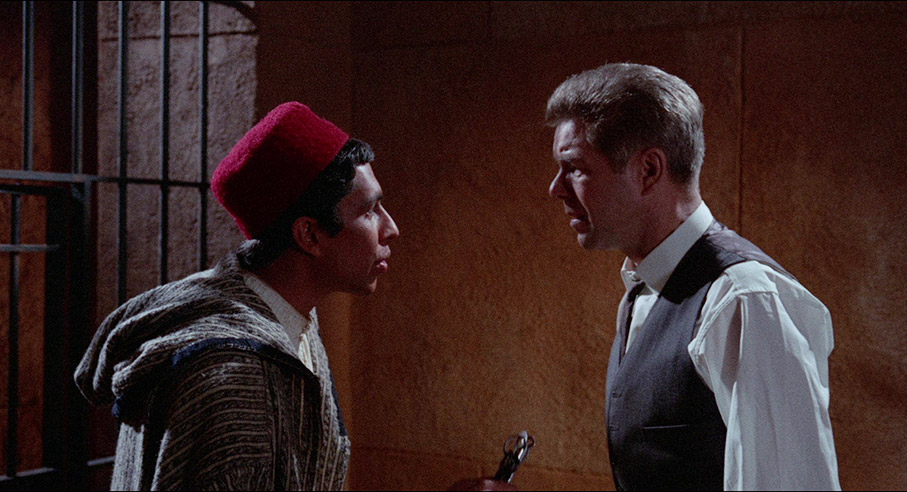
Introduction by Vic Pratt (6:33)
Here Vic Pratt notes a lack of opulence and location filmmaking in what he describes as a more claustrophobic follow-up film, as well as picking up on some of the more visible period incongruities and suggesting that while Nigel Green made Nayland Smith a man of action, Douglas Wilmer’s interpretation is a little too close to his portrayal of Sherlock Holmes in the TV series that made his name.
Kim Newman: Pages of Peril (20:37)
Kim Newman takes a detailed look at author Sax Rohmer, with particular emphasis on his Fu Manchu novels, all of which he appears to own in well-thumbed paperback. He discusses the cultural and literary influences on the creation of the character and how the style of the novels developed over time, as well as Fu Manchu’s brief run as a character in Marvel comics. He doesn’t shy away from the racism that runs throughout the books, and describes them as the definition of a guilty pleasure.
Theatrical Trailer (2:25)
A busy trailer that emphasises the action and includes what in retrospect feels like a big spoiler, but it flits by so quickly that it probably isn’t.
TV Spot (0:22)
Stuff happens without context or clarification in a brief TV spot that almost looks as if it was filmed off a monochrome television screen but was probably sourced from tape.
Image Gallery
76 screens of posters, press book pages and promotional photos, both monochrome and colour and including some of those garishly coloured-in front-of house stills. Given that the film was shot in colour and there were colour stills available, the very existence of these images continues to mystify me.
THE VENGEANCE OF FU MANCHU
Audio Commentary with Kevin Lyons and Jonathan Rigby
Lyons and Rigby are back to comment on the film they both regard as the best of the series, which although makes them the ideal people to talk about it, does mean I found myself disagreeing with just a few of their observations. There are several quotes from Douglas Wilmer’s autobiography, none of which are exactly complimentary about the film or his role as Nayland Smith, notes on some of the actors – including some of those with speaking roles who were mysteriously uncredited – and it’s here that I learned about the missing martial arts sequence that I’d just love to see but that is probably lost forever now. While both men do touch on a couple of the more implausible plot elements, they don’t seem particularly bothered by them. Each to his own.
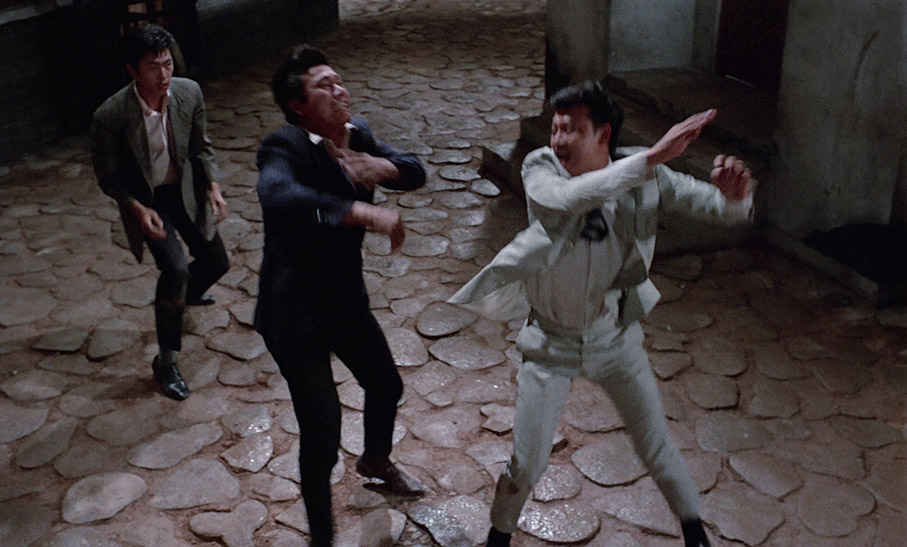
BEHP Interview with Jeremy Summers (71:47)
A 2001 British Entertainment History Project interview with director Jeremy Summers in which he talks about his showbusiness background, his journey into the film industry and gradual move up the ladder to working as first assistant and second unit director on The Dam Busters, before moving on to specifics of his subsequent film and TV career. We get some detail on his work with Tony Hancock on The Punch and Judy Man, and not for the first time in this set there are expressions of mirth all round when Harry Alan Towers comes up. He has stories about working with David Lean and John Huston, as well as doing odd jobs on Richard Lester’s surreal comedy short, The Running, Jumping & Standing Still Film, and seems to have particularly enjoyed his later work on British TV soaps such as Coronation Street.
Introduction by Vic Pratt (7:01)
Here Vic Pratt praises director Jeremy Summers for the look of the film but does highlight Fu Manchu’s over-complicated plans, the groovy soundtrack and the mixed-up period details. He also amusingly describes the plots from hereon in as “the kind of thing you might jot down whilst drunk in a pub garden on the back of a fag packet.”
Jonathan Rigby: Tall, Lean and Feline (49:18)
Jonathan Rigby takes a break from his commentaries to talk about Christopher Lee and the roles that led him to play Fu Manchu, before exploring his portrayal in these five films in some detail. He has plenty of sometimes damning quotes from Lee about the series that he communicated to his fan club at the time, identifies Lee’s stillness in the role as a key reason for its success, and reveals that Sax Rohmer’s widow visited the set of one of the shoots and remarked that the costumed and made-up Lee was the image of the man her husband saw in London who inspired him to create the character.
Anthony Waye: The Cheque’s in the Post (5:00)
First assistant director Anthony Waye looks back at his time working for Harry Alan Towers, whom he recalls typing scripts out on bumpy propellor-driven plane journeys and shooting three scenes for three movies on the same set on the same day. The title of this piece is a punchline to a story that underlines Towers’ penchant for working on the cheap.
Alternative Philippine Title Sequence (3:20)
Effectively the same as the UK title sequence but with one very significant change in the shape of a pre-title credit that has Tony Ferrer (who plays inspector Ramos) as the star and places his name above that of Christopher Lee and in a larger font size.
Theatrical Trailer (2:28)
About two-thirds of the admittedly thin plot is outlined in this workmanlike but unexciting sell.
Image Gallery
66 screen of promotional still, posters and press book pages.
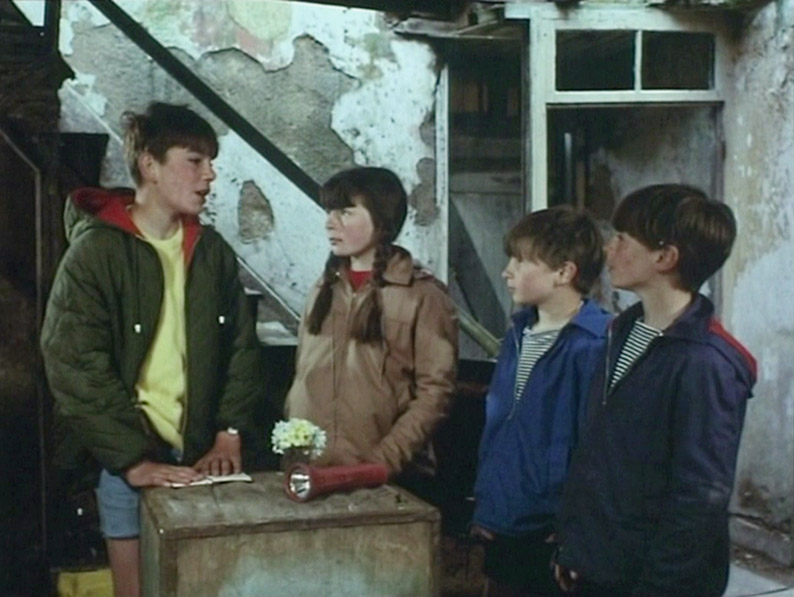
The Ghost of Monk’s Island (1966) (92:29)
It’s not often that you get an entire feature film as a special feature on a Blu-ray release, but that’s what we have here. Co-directed by Jeremy Summers and Jan Darnley-Smith in 1966 for the Children’s Film Foundation, it tells the story of four children whose boat trip goes awry and shipwrecks them on the deserted Monk’s Island, which is reputed to be haunted by the ghost of a long-dead monk, hence the island name and the title of the film. As a kid, I used to watch films like this, sometimes in serial forms, which was how this originally screened, almost every week at Saturday morning pictures (I’m not explaining what that was to those too young to remember) and as a kid I’m sure I would have really enjoyed a film in which kids of my age adapt to their situation and do what’s needed to survive without panicking or fighting amongst themselves. They even get to outwit a brutish escaped criminal who’s hiding out on the island awaiting promised transport to who knows where. Imagine an Enid Blyton tale titled Five Get Stuck on a Desert Island but without Timmy the dog and only one girl. As an adult with decades of film watching under my belt, I watched it with a nostalgic smile but a more critical eye. I’m not big on movies featuring plucky kids or of those particularly British child actors of years past whose line delivery favours clear diction over realistic modes of speech, and I was oddly surprised by the predictability of the storytelling and the wooden performances of a couple of the supporting characters. But that’s because I’m a cynical old git and no longer part of the film’s target audience. Putting that aside, I think this is a wonderful inclusion that I have no doubt many will delight in.
THE BLOOD OF FU MANCHU
Audio Commentary with David Flint and Adrian J. Smith
This audio commentary by Movies and Mania website editor David Flint and The Reprobate website editor Adrian J. Smith is delivered from the viewpoint of devoted fans of the cinema of Jess Franco, which means they tend to be more forgiving of the film’s issues than others might be, which again makes them the ideal pick to provide a commentary for this film. If you’re working your way through the special features in this set in the order they appear on the discs then you’ll already have heard some of what Flint and Smith have to say, but there is still some interesting background information and some pertinent observations made here. As Francophiles, so to speak, they do sometimes provide justification for directorial decisions that I’m not completely convinced by, and they get a little tied up with the whole issue of casting Caucasian actors in Oriental roles. This peaks with an ill thought-through claim about why Sean Connery being made up to look Japanese in You Only Live Twice should be similarly reassessed. The thing is, he wasn’t a Caucasian actor playing a Japanese character, he was a Caucasian actor playing a Caucasian character in a movie in which that character is made up to look (unconvincingly – blame the makeup department) Japanese as part of the plot. Not quite the same thing, guys.
Introduction by Vic Pratt (7:13)
Pratt kicks off here by describing The Blood of Fu Manchu as “an interesting late addition to a series that was starting to run out of steam,” before talking about director Jess Franco, the film’s Euro-sleaze elements, a possible Sergio Leone influence, the bemusing inclusion of a scene from The Girl From Rio and, of course, the period anachronisms.
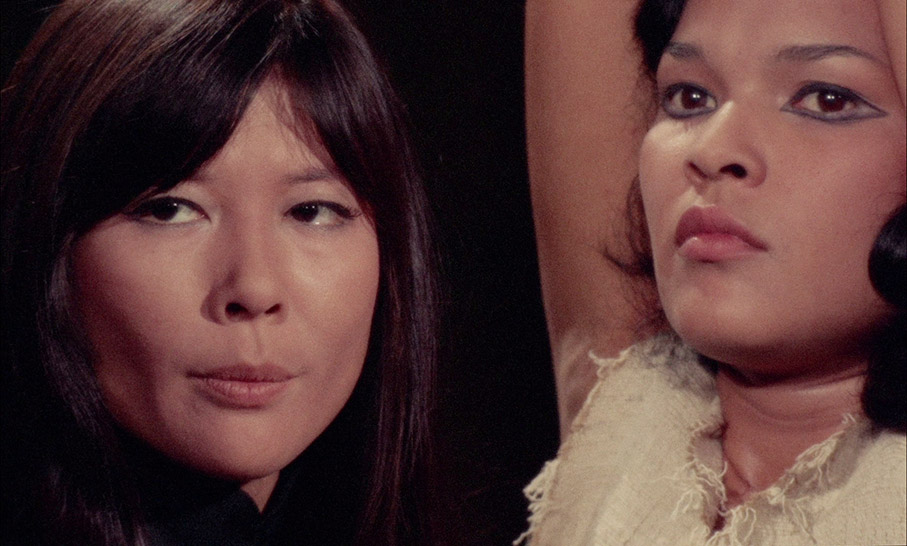
The Men Who Killed Fu Manchu?: Stephen Thrower on Franco and Towers (41:05)
Author and horror film expert Stephen Thrower looks at the careers of Jesús (aka Jess) Franco and Harry Alan Towers and explores how they came together to work on a series of films that began with the final two instalments in the Fu Manchu series. There’s a great deal of useful detail on both men and their working relationship here, and Thrower also offers some interesting opinions on their Fu Manchu films and gives his reasons for preferring The Castle of Fu Manchu over its predecessor, despite admitting that it’s a bit of a mess, albeit a rather good looking one. He makes some really good points during the course of a most engaging 41 minutes, and suggests a problem with the films is that they stripped Sax Rohmer’s stories of the characters’ racist motivation – a good thing – but failed to replace it with anything concrete, with the result that Fu Manchu effectively became “a brand without a company.”
Ray Andrew: Any Way to Save Money (10:58)
Clapper loader (a job I also did myself briefly in my younger days) on the film, Ray Andrew, recalls how he landed the job of working on the Fu Manchu movies, shares fond memories of working with Don Sharp, Jesús Franco and Christopher Lee, and remembers that Harry Alan Towers would put his girlfriend Maria Rohm in every film that he could and that she had a foul temper. He also remembers the crew being invited to have lunch once with Towers, who spent the whole time scribbling on napkins what turned out to be an outline for Circus of Horrors, which began filming before the script was anything close to complete.
Alternative Title Sequences
Included here is the pre-release title sequence as Kiss Me to Death (1:37), the titles used on the US video release where it became Against All Odds (1:31), and the Spanish release titles, Fu Manchú y el beso de la muerte (1:32).
Colour Tests (0:45)
Silent footage of a big close-up of Fu-Manchu’s face testing different colour filters, plus a two-shot of Fu Manchu and Lin Tang arranged for the stylised opening title sequence.
UK Theatrical Trailer (2:57)
A workmanlike trailer that at least gives an idea of what the film’s about.
US ‘Kiss and Tell’ Theatrical Trailer (1:40)
A very 60s trailer with some nudity, lots of action and psychedelic graphics. Apparently it stars “Christopher Lee as Mr. Evil.” Not Doctor Evil, then?
Image Gallery
88 screens of promotional material, including photos, posters, lobby cards and press book pages.
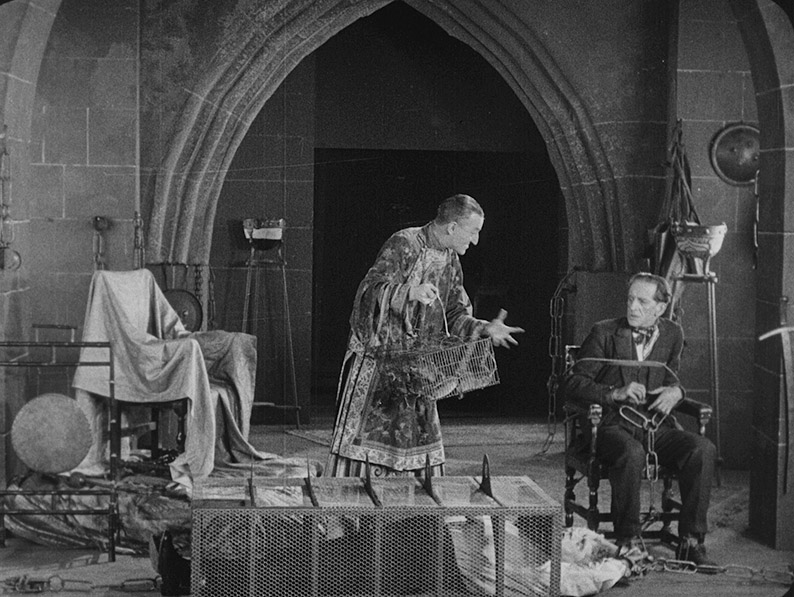
The Mystery of Dr. Fu-Manchu: 'The Fiery Hand' (1923) (36:18)
One of a series of short film adaptations made of Sax Rohmer’s stories starring Harry Agar Lyons, the first actor to play Fu Manchu on film. It initially plays out as a Sherlock Holmes-like tale, as Nayland Smith (Fred Paul) is called on to investigate a supposedly haunted house that just might be Fu-Manchu’s latest hideout (and yes, the hyphen was in his name back then). It even includes a very Holmes/Watson moment when Smith enters wearing a disguise that completely fools Dr. Petrie (Humberston Wright). Lyons doesn’t even try to look Chinese, but when it comes to torturing Smith he’s in a different league to Lee’s incarnation in a scene that has a definite Room 101 vibe and actually had me just a weeny bit tensed up. This film has clearly undergone a restoration and despite a fair few remaining instances of damage, it looks terrific for a work of this vintage. It can be played with or without a score arranged, produced and mixed by Tom Blackford and performed by the band Peninsula that combines creepy electronic tones with overpowered prog-rock and only intermittently seems to fit the on-screen action.
THE CASTLE OF FU MANCHU
Rosalba Neri: From Alicante to Istanbul (13:10)
Actor Rosalba Neri, who plays Omar Pashu’s smart-dressing chief operative Lisa in the film, shares happy memories of working with Jess Franco, including stories of his 1969 99 Women and, of course, The Castle of Fu Manchu. She reveals her approach dying on screen (it seems this happened to her a lot), and remembers enjoying conversations with Christopher Lee, who spoke perfect Italian, one of six languages in which the actor was fluent. This interview is also conducted in Italian, but with optional English subtitles that kick on by default for those less fluent than Mr. Lee.
Introduction by Vic Pratt (6:53)
Here Vic Pratt talks about the repurposing of sequences from other films, the distinctly Jess Franco touches, the film’s depiction of women and the anachronisms. He also notes that this is a surprisingly chaste work given the nudity in its predecessor.
Archival Interview with Harry Alan Towers (44:43)
Framed 4:3 and in standard definition, this is a welcome archival interview with the man who is discussed in almost every other extra in this set. He rarely pauses for breath during the course of the 45 minutes for which the interview runs and focusses primarily on his early days, getting into radio and writing and then into TV and eventually becoming a film producer. He has recalls working with Orson Welles, John Gielgud and Ralph Richardson on a radio adaptation of Arthur Conan-Doyle’s Holmes-back-from-the-dead story, The Empty House, and teasingly reveals that he is working on a film of Moll Flanders with director Ken Russell and has plans for another about Oscar Wilde for which he wants Patrick Stewart in the lead. Rather sadly, neither film ended up being made. Probably the most surprising admission comes when he talks about meeting actor Maria Rohm, whom he subsequently married and had been with for 42 years at this point. “I have one very simple philosophy with her,” he reveals. “I always tell her the truth. If I’m going to screw somebody, or have the intention of screwing them, I tell her first.”
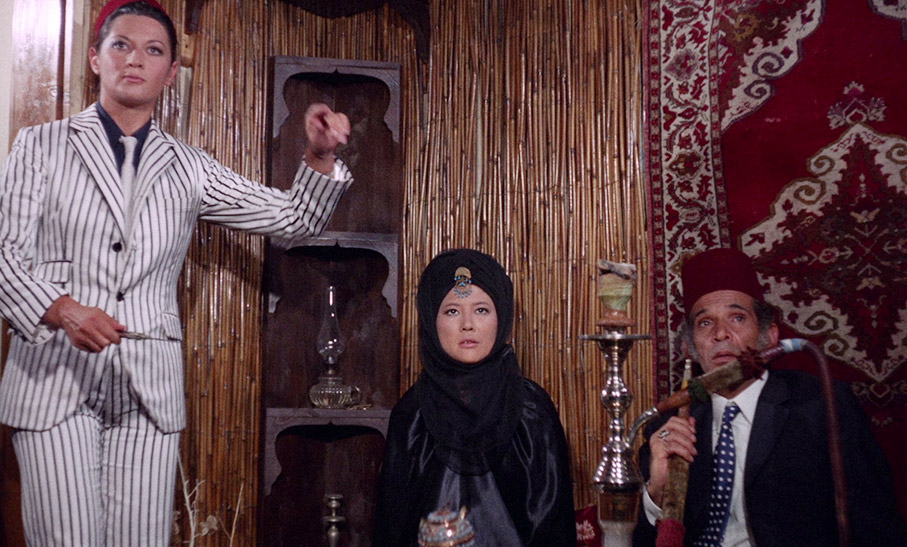
Alternative Title Sequences
Here we have a pre-release title sequence where the film’s title is Assignment Istanbul (2:09) and the Spanish video release titles El Castillo de Fu-Manchu (2:09), where the original sequence and its live action backdrop have been replaced with credits that play out over a painting of a bright red dragon against a vivid blue background.
Theatrical Trailer (2:27)
An urgently paced and action-packed sell. Genuinely surprised they had the nerve to include some of that borrowed opening sequence, including a few monochrome clips from A Night to Remember.
Image Gallery
39 screens of press photos, lobby cards, posters and press book pages. It somehow seems appropriate that this problematic final film in the series should have fewer images than its predecessors.
The Further Mysteries of Dr. Fu-Manchu: ‘The Coughing Horror’ (1924) (30:31)
Another of the silent adaptations of the Sax Rohmer stories starring Harry Agar Lyons as Fu Manchu begins with an interesting caption that provides the perfect get-out clause for Lyons’ completely lack of oriental features by claiming that Fu-Manchu (yep, the hyphen is still being used) is not Chinese but a man who has become a Chinese national. Here Nayland Smith (once again played by Fred Paul) and Dr. Petrie (Humberston Wright) is approached by a man named Antonio Strozza (Fred Morgan), who offers to reveal the location of Fu-Manchu’s hideout as payback for the death of his brother at the master criminal’s hands. Strozza and Smith are both captured by Fu-Manchu and threatened with horrible torture (Strozza comes within a whisper of having his tongue burned out with a white-hot iron), and when they escape they are individually attacked by a half-man, half-ape creature that looks like it escaped from the island of Dr. Moreau. Once again this has clearly been restored and while the picture is not quite as crisp as The Fiery Hand, it still looks pretty darn good for its age. Again this has an optional Peninsula score that’s very much in the same vein as its predecessor.
ALSO
Booklet
No surprise that a booklet accompanying a five-film set is a weighty tome, at least by booklet standards. Weighing in at 118 pages, it kicks off with credits for all of the main features, then launches into a concise essay on the series by Tim Lucas, who explores the influences on the original novels and discusses the books themselves, the early film adaptations and the movies in this set. Following this, Jeff Billington delves into the life and colourful career of producer Harry Alan Towers, providing specific details of the charges that led to his self-imposed exile from America. Next up is a piece on author Sax Rohmer that includes a biography from the press book of The Face of Fu Manchu and extracts from his first Fu Manchu novel. Then we have an interesting archive piece titled Fu Manchu and Co that was first published in the Atchison Daily Globe on 21 May 1913, after which is a 1965 article that appeared in American newspapers anticipating the release of the then in-production The Brides of Fu Manchu and includes quotes from Sax Rohmer’s widow. Then we have extracts from a promotional leaflet that’s brimming with comically suspect movie tie-in suggestions, such as displaying large bottle of ‘Fu Manchu’s Evil Poison’ in the cinema lobby and dressing up the ushers, usherettes and ticket sellers in “Chinese garb.” Hmm. We also get news of a promotional single titled Don’t Fool With Fu Manchu by the Rockin’ Ramrods. Pardon me? There’s plenty more in this section, including a reproduction of the aforementioned Fu Manchu for Mayor poster and suggestions for competitions. I almost feel the need to pause for breath before going on, because there’s more. Following this is a short piece on Dublin’s Kilmainham jail, whose courtyard was the location for the opening scene of The Face of Fu Manchu, after which are extracts from the Anglo-Amalgamated UK pressbook containing biographies of some of that film’s actors, including Tsai Chin and Karin Dor. Biographies of the three directors on the series – Don Sharp, Jeremy Summers and Jesús Franco – are followed by a selection of contemporary reviews of the films in the series, many of which are more positive than you might expect. Jeff Billington returns with an appreciation of The Ghost of Monk’s Island, after which are credits for The Fiery Hand and The Coughing Horror and a piece by Nathalie Morris on the silent film adaptations of the stories. Plenty of detail is provided on the restorations and the whole booklet is handsomely illustrated.
As anyone who read my recent blog will be aware, I’ve been insanely busy with my day job of late, and this extraordinary box set not only contains five feature films but over 24 hours of special features, and as a result this review has taken over three weeks to complete, has a frankly silly word count and is horribly late. It’s a fascinating film series, in part for the changes it undergoes over its lifespan, the varying styles of its directors, the gradually waning quality of the Towers screenplays, the delicious supervillain performances of Christopher Lee and Tsai Chin, the often impressive visuals, and the elements that have fallen victim to changing times. Views differ even within the special features in this box set on which is the finest film and even who is the best Nayland Smith, and that means there’s a good chance that if you sit down and watch all five you’ll disagree with much of what I’ve written above. I’m fine with that, and if you enjoy all of them then you’ll get the absolute most out of this feature-packed collection. Either way, this is a brilliant release that comes highly recommended. Right, now where’s that six film Columbia Noir #1 set?
<< Part 1: The Films
|